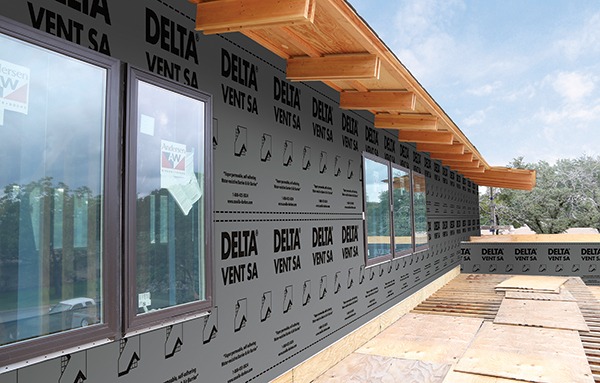Air Barriers
By Peter Barrett

Copyright Denver Botanic Gardens. Photo by Scott Dressel-Martin
For both new construction and remodeling projects, the right combination of air barriers and insulation is important to the overall effectiveness of a masonry or wood-framed wall system. Increasingly, architects and builders recognize that a well-performing air barrier will maximize the effectiveness of the insulation, help reduce energy costs, and avoid potential moisture problems.
Leaks: A Big Issue
Air leaking into the walls can be a significant problem for buildings. Air penetrates through the cladding or masonry, through penetrations and fasteners, or through window and door openings, wasting energy. This non-conditioned air makes the insulation less effective. Contractors are the last line of defense to ensure that the structure is airtight. Attention to detail during installation is critical, but using high-performance air barriers makes it easier to end up with an energy-saving, airtight structure.

Reducing Risk
House wraps have been the generally accepted weather enclosure solution for many years. Over time, however, house wraps have gone from being an adequate solution to one that is now viewed as just “good enough” to meet code. Technology has made higher-performance air and water barriers a preferred choice for contractors and builders who aren’t satisfied with just meeting building codes.
Typically, building codes take time to catch up to product improvements. However, forward-thinking builders and contractors are using higher-performing air and water barriers before they are required by building codes. Not only does this keep them up to date with current thought in building science, but it also keeps these builders ahead of their less progressive competitors.
A contractor can be at greater risk because mechanically attached (nailed) house wraps are more prone to installation problems. Frequently, the wrong type of fastener is used or seams and penetrations are not completely taped and sealed, allowing air to flow past the air barrier.
House wraps are also prone to being ripped, torn or even blown off due to high winds that hit the structure before the cladding or masonry exterior has been installed to protect the house wrap.
As more homeowners go online to educate themselves, they have access to home energy auditors with tools like thermography and infrared thermometers. What used to be an acceptable level of air leakage is no longer acceptable. Blower door testing and HERS ratings are focusing attention on the integrity of the air barrier.
When leaks in the air barrier are identified as the problem, the contactor is the most likely person to be blamed. The contractor may then be expected to remedy the situation, which can be expensive if it requires removal of the cladding. The architect, builder and house wrap manufacturer will all point out that it was the contractor’s installation errors that caused the problems.
Two Choices
Contractors have two choices to protect themselves while assuring the builder and homeowner of an airtight enclosure.
The first choice involves continuing to use a house wrap product. In this case, the contractor needs to make sure that the installers pay extra attention to the installation details. The contractor will need to make sure every detail is inspected, then plan that some details will have been missed and need to be corrected by his crew.
The contractor will also need to inspect the barrier an additional time just before the exterior cladding is installed to see if there has been any damage caused by high winds or openings created in the barrier by other trades (e.g., utilities). The remaining openings will need to be repaired one final time before the final cladding is installed.
The second choice for the contractor is to insist on or encourage the builder to use a higher-performing, fully adhered air and water barrier, such as DELTA-VENT SA from Cosella-Dörken or VP 160 by Henry.
Self-adhered air and water barriers eliminate many potential problems with fasteners and poorly taped (or untaped) overlaps and seams. They also won’t be damaged by high winds. A fully adhered air barrier costs more than an ordinary house wrap but saves the time it takes to install a mechanically fastened house wrap correctly and repair subsequent installation issues.
A fully adhered membrane also makes it easier for the builder to pass a blower door test and improve the HERS rating, while protecting the contractor from costly callbacks.
It’s a New World
With the growing focus on energy efficiency and technology that can quantify a structure’s air leakage rate, contractors need to protect themselves by knowing what products will result in the best results. Contractors can no longer just do what they are told or be satisfied with just meeting building code.
Peter Barrett is product manager for Cosella-Dörken Products, Inc. He can be reached at pbarrett@cosella-dorken.com.